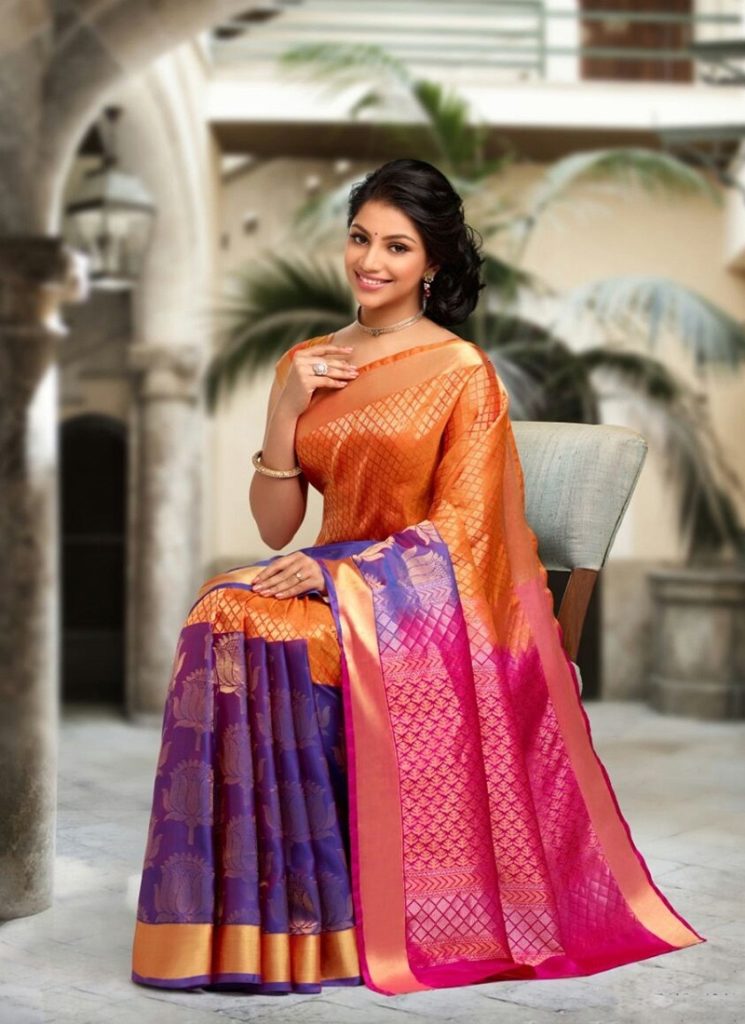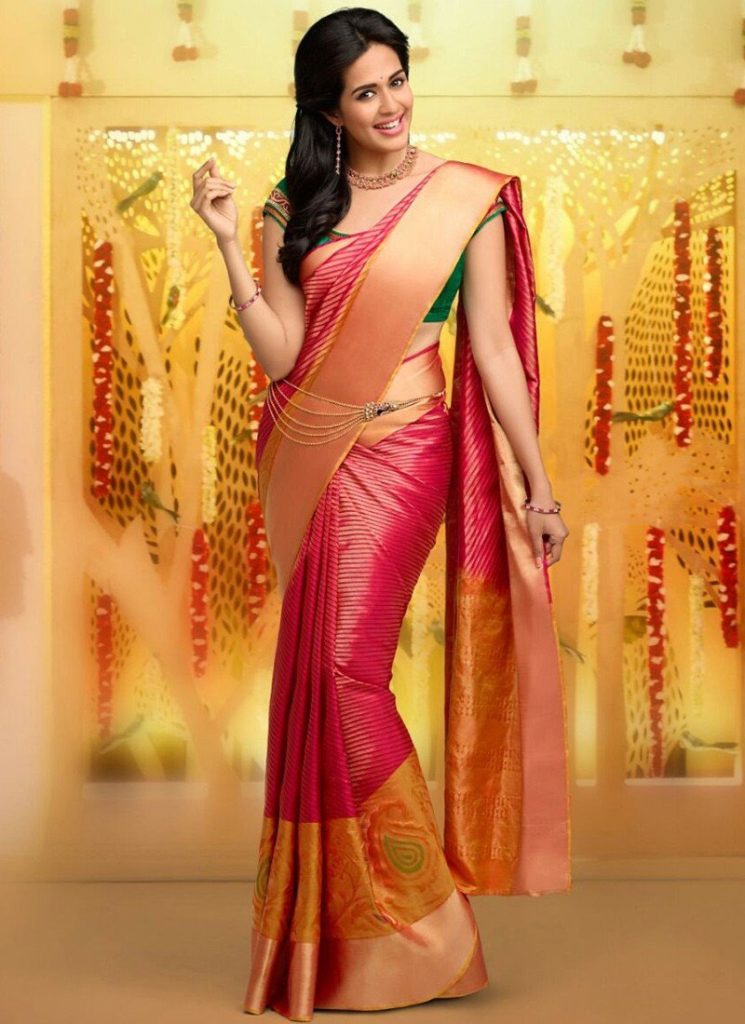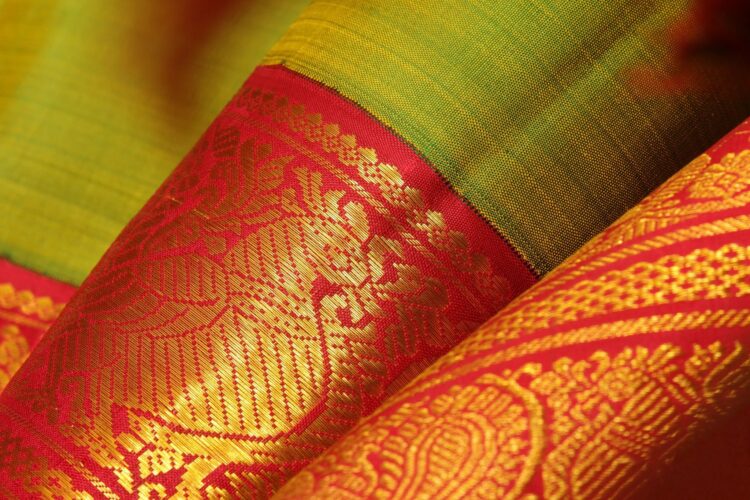Table of Contents
Origination and History:
The Kanchipuram saree originated in a town called Kanchipuram or Kancheepuram in Chennai, Tamil Nadu. The town was ruled by many dynasties right from the Chola dynasty to the Mughals and the British. But it was during the reign of Krishnadevaraya from the Vijayanagara Dynasty that the town saw its peak.
It was during this time that two weaving communities from Andhra Pradesh, the Devangas and the Saligars moved to Kanchipuram. The city is full of temples that bore evidence to the heritage of the famous Dravidian empire. The migrated weaving community gave the Kanchipuram saree the status of what it enjoys today. The Weavers used their weaving skills and added motifs inspired from the rich architecture of temples.
With time, the kanchipuram silk saree gained popularity and became a necessity during weddings, festivals and religious ceremonies.
There’s another tale according to Hindu Mythology, that the Kanchipuram silksaree weavers are descendants of Sage Markanda. They were the weavers of God who weaved tissue from lotus fiber. Silk was a preferred material by Lord Vishnu.
The weaving process of a Kanchipuram Saree:
A Kanchipuram saree is woven from pure mulberry silk thread. The mulberry silk comes from South India and the thread or zari create borders and designs come from Gujarat.
The weavers use three shuttles when weaving a Kanchipuram silk saree. There is an assistant of the weaver who works on the left side of the shuttle while the weaver himself works on the right side.
A warped frame is used to weave the silk. The warp has about 60 holes with 240 threads. About 250 to 3000 threads are in the weft giving it a sturdy feel.

What’s interesting about a Kanchipuram saree is its border. Often contrasting borders are what adds appeal to a silk saree. In the case of a contrasting border, the border has to be woven separately. Contrast kanchipuram silk sarees are made by kanjivaram silks. It is after that it is interlocked with the saree. One weaver works on the threads while the other concentrates on the border color. There are times when certain silk sarees have borders on both sides. It takes a minimum of three shuttles with such silk sarees.
The winning point of a Kanchipuram saree has to be Pallu. The Pallu’s which stand out, are woven separately and then later on like the borders are interlocked with the silk saree. There is a distinctive zig-zag line where the pallu meets the silk saree.
History has it, that even if a silk saree tears, the borders, and the pallus won’t detach from the saree. Also, one can make out the skill of an artisan or weaver that has woven your silk saree. The next time you go out shopping for a Kanchipuram check out on the parts where the borders and the pallu meet the silk saree. It is said that the more skilled the artisan or the weaver, the beautifully interlocked or camouflaged the border and the pallu will be to the silk saree. Plus, a genuine silk saree will always have the borders and pallu interlocked to the saree.
The gold or silver zari to create the borders and pallus come from Gujarat. The silk thread is first dipped in rice water and then left to dry out in the sun. This helps to increase the thickness and the stiffness of the threads. The silk thread is interlocked with a thin silver wire and woven through first. After this, the procedure is completed by woving the golden thread.
The zari’s constitute 57 percent silver and 0.6 percent gold. It takes about a 10 to 15 days to weave a single silk saree. But the duration may differ depending on the design and intricacies required in the saree.
Design and motifs:
The design and motifs are traditionally temple borders, checks, stripes and florals or buttas. The motifs are inspired by the images and sculptures of the South Indian temples giving rise to motifs of birds, animals, and even leaves.
Kanchipuram sarees owing to its origination often carry the paintings of Raja Ravi Varma woven into the saree. It also carries designs from the Mahabharata and Ramayana.
With time, designs that simple like golden dots is also gaining popularity.
The Kanchipuram saree has been largely classified into five different types-
- Plain Kanchipuram Saree with Gold Border: The saree has a contrast border or a zari border with a single base color of the saree. The border is interlocked with a zigzag line.
- Temple Border Kanchipuram Saree: The temple borders have triangular or zigzag designs on the border and sometimes even between the pallu and the body part.
- Modern Kanchipuram Saree: With never techniques and styles, Kanchipuram sarees have a lot of modern designs and motifs coming into being.
- Traditional Kanchipuram Silk Saree: The traditional sarees adorn the motifs like checks, coins, and chakras. Their distinctive features are temple borders and traditional colors. They hold significance as bridal sarees or sarees worn during pujas.
- Floral Weave Kanchipuram Saree: They are the ones that have floral or paisley motifs. These motifs cover the body saree and often have a zari in the pallu portion.

Evolution and variety:
The Kanchipuram sarees which used to be nine yards have over the years evolved and have become more practical as a six-yard saree now. As gold and silver zaris is expensive, it is now being replaced by metal and copper zari. This has helped in bringing down the cost of the Kanchipuram making it more to the masses.
Original pure silk and pure zari saree can cost anywhere between Rs.7,000 and Rs.2,00,000. The budget sarees which are now half silk and half synthetic and the zari which is of metal and copper can cost somewhere between as low as Rs. 500 to Rs. 2000.
Care and Maintenance:
Dry clean the saree for cleaning purposes. If you want to wash the saree, it’s advisable to not use soap in the first three washes. A rinse in cold water should do. Store the saree in a plastic bag in a cool and open space.
